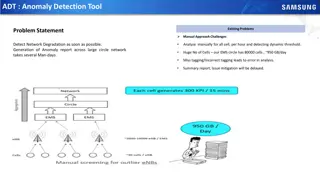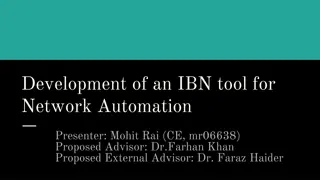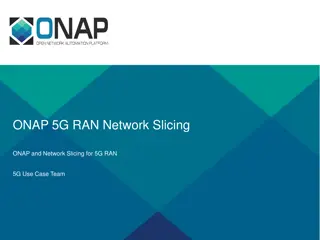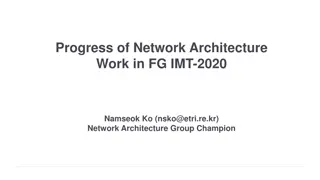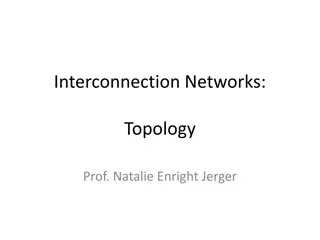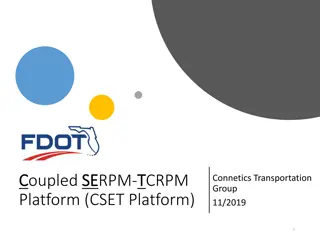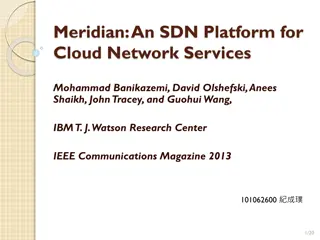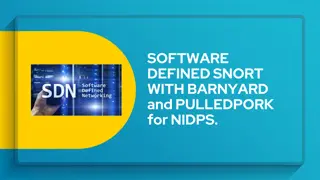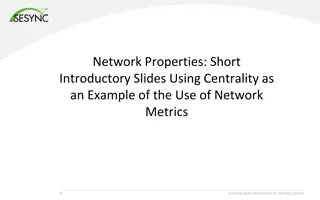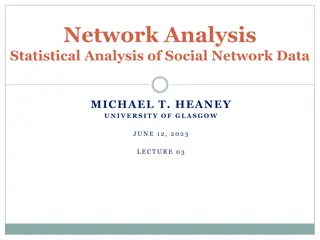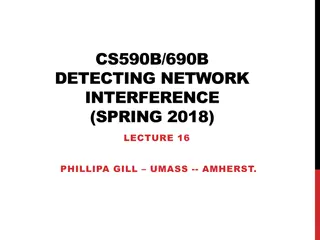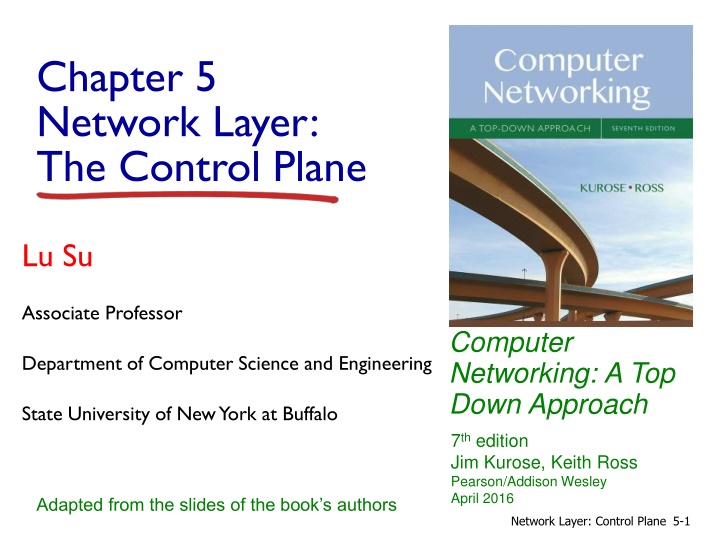
Network Layer Control Plane Overview
Explore the network layer's control plane, covering routing protocols, SDN, ICMP, and network management. Learn about the distance vector algorithm and Bellman-Ford equation for path estimation and convergence in network routing.
Download Presentation

Please find below an Image/Link to download the presentation.
The content on the website is provided AS IS for your information and personal use only. It may not be sold, licensed, or shared on other websites without obtaining consent from the author. If you encounter any issues during the download, it is possible that the publisher has removed the file from their server.
You are allowed to download the files provided on this website for personal or commercial use, subject to the condition that they are used lawfully. All files are the property of their respective owners.
The content on the website is provided AS IS for your information and personal use only. It may not be sold, licensed, or shared on other websites without obtaining consent from the author.
E N D
Presentation Transcript
Chapter 5 Network Layer: The Control Plane Lu Su Associate Professor Computer Networking: A Top Down Approach Department of Computer Science and Engineering State University of New York at Buffalo 7th edition Jim Kurose, Keith Ross Pearson/Addison Wesley April 2016 Adapted from the slides of the book s authors Network Layer: Control Plane 5-1
Chapter 5: outline 5.1 introduction 5.2 routing protocols link state distance vector 5.3 intra-AS routing in the Internet: OSPF 5.4 routing among the ISPs: BGP 5.5 The SDN control plane 5.6 ICMP: The Internet Control Message Protocol 5.7 Network management and SNMP Network Layer: Control Plane 5-2
Distance vector algorithm Bellman-Ford equation (dynamic programming) let dx(y) := cost of least-cost path from x to y then dx(y) = min {c(x,v) + dv(y) } v cost from neighbor v to destination y cost to neighbor v min taken over all neighbors v of x Network Layer: Control Plane 5-3
Bellman-Ford example 5 clearly, dv(z) = 5, dx(z) = 3, dw(z) = 3 3 v w 5 2 B-F equation says: u z 2 1 3 du(z) = min { c(u,v) + dv(z), c(u,x) + dx(z), c(u,w) + dw(z) } = min {2 + 5, 1 + 3, 5 + 3} = 4 1 2 x y 1 node achieving minimum is next hop in shortest path, used in forwarding table Network Layer: Control Plane 5-4
Distance vector algorithm Dx(y) = estimate of least cost from x to y x maintains distance vector Dx = [Dx(y): y N ] node x: knows cost to each neighbor v: c(x,v) maintains its neighbors distance vectors. For each neighbor v, x maintains Dv = [Dv(y): y N ] Network Layer: Control Plane 5-5
Distance vector algorithm key idea: from time-to-time, each node sends its own distance vector estimate to neighbors when x receives new DV estimate from neighbor, it updates its own DV using B-F equation: Dx(y) minv{c(x,v) + Dv(y)} for each node y N under minor, natural conditions, the estimate Dx(y) converge to the actual least cost dx(y) Network Layer: Control Plane 5-6
Distance vector algorithm each node: iterative, asynchronous: each local iteration caused by: local link cost change DV update message from neighbor distributed: each node notifies neighbors only when its DV changes neighbors then notify their neighbors if necessary wait for (change in local link cost or msg from neighbor) recompute estimates if DV to any dest has changed, notify neighbors Network Layer: Control Plane 5-7
Dx(z) = min{c(x,y) + Dy(z), c(x,z) + Dz(z)} = min{2+1 , 7+0} = 3 Dx(y) = min{c(x,y) + Dy(y), c(x,z) + Dz(y)} = min{2+0 , 7+1} = 2 node x table cost to cost to x y z 0 2 7 x y z 0 2 0 1 7 1 0 x y z x y z 3 2 from from node y table cost to y x y z 2 1 x y z z 2 0 1 x 7 from node z table cost to x y z x y z from 7 1 0 time Network Layer: Control Plane 5-8
Dx(z) = min{c(x,y) + Dy(z), c(x,z) + Dz(z)} = min{2+1 , 7+0} = 3 Dx(y) = min{c(x,y) + Dy(y), c(x,z) + Dz(y)} = min{2+0 , 7+1} = 2 node x table cost to cost to cost to x y z 0 2 7 x y z 0 2 0 1 7 1 0 x y z 0 2 3 2 0 1 3 1 0 x y z x y z 3 2 x y z from from from node y table cost to cost to cost to y x y z x y z 0 2 7 2 0 1 7 1 0 x y z 0 2 3 2 0 1 3 1 0 2 1 x y z x y z 2 0 1 z x y z x 7 from from from node z table cost to cost to cost to x y z 0 2 7 2 0 1 3 1 0 x y z 0 2 3 2 0 1 x y z x y z x y z x y z from from from 7 1 0 3 1 0 time time Network Layer: Control Plane 5-9
Distance vector: link cost changes link cost changes: node detects local link cost change updates routing info, recalculates distance vect or if DV changes, notify neighbors 1 y 4 1 x z 50 good news travels fast t0 : y detects link-cost change, updates its DV, informs its neighbors. t1 : z receives update from y, updates its table, computes new least cost to x , sends its neighbors its DV. t2 : y receives z s update, updates its distance table. y s least costs do not change, so y does not send a message to z. * Check out the online interactive exercises for more examples: http://gaia.cs.umass.edu/kurose_ross/interactive/ Network Layer: Control Plane 5-10
Distance vector: link cost changes link cost changes: node detects local link cost change bad news travels slow - count to infinity problem! 44 iterations before algorithm stabilizes: see text 60 y 4 1 x z 50 node y table node y table node y table node y table cost to cost to cost to cost to x y z 6 0 1 5 1 0 x y z 4 0 1 5 1 0 x y z 8 0 1 7 1 0 x y z 6 0 1 7 1 0 y z y z y z y z from from from from node z table node z table node z table node z table cost to cost to cost to cost to x y z 6 0 1 5 1 0 x y z 4 0 1 5 1 0 x y z 8 0 1 7 1 0 x y z 6 0 1 7 1 0 y z y z y z y z from from from from Network Layer 4-11
Distance vector: link cost changes poisoned reverse: If Z routes through Y to get to X : Z tells Y its (Z s) distance to X is infinite (so Y won t route to X via Z) 60 y 4 1 x z 50 node y table node y table node y table node y table cost to cost to cost to cost to x y z 60 0 1 1 0 x y z 4 0 1 1 0 x y z 51 0 1 50 1 0 x y z 60 0 1 50 1 0 y z y z y z y z from from from from node z table node z table node z table node z table cost to cost to cost to cost to x y z 60 0 1 5 1 0 x y z 4 0 1 5 1 0 x y z x y z 60 0 1 50 1 0 y z y z y z y z 0 1 50 1 0 from from from from 4-12 Network Layer
Distance vector: link cost changes link cost changes: node detects local link cost change bad news travels slow - count to infinity problem! 44 iterations before algorithm stabilizes: see text 60 y 4 1 x z 50 poisoned reverse: If Z routes through Y to get to X : Z tells Y its (Z s) distance to X is infinite (so Y won t route to X via Z) will this completely solve count to infinity problem? Network Layer: Control Plane 5-13
Comparison of LS and DV algorithms message complexity LS: with n nodes, E links, O(nE) msgs sent DV: exchange between neighbors only convergence time varies speed of convergence LS: O(n2) algorithm requires O(nE) msgs may have oscillations DV: convergence time varies may be routing loops count-to-infinity problem robustness: what happens if router malfunctions? LS: node can advertise incorrect link cost each node computes only its own table DV: DV node can advertise incorrect path cost each node s table used by others error propagate thru network Network Layer: Control Plane 5-14



